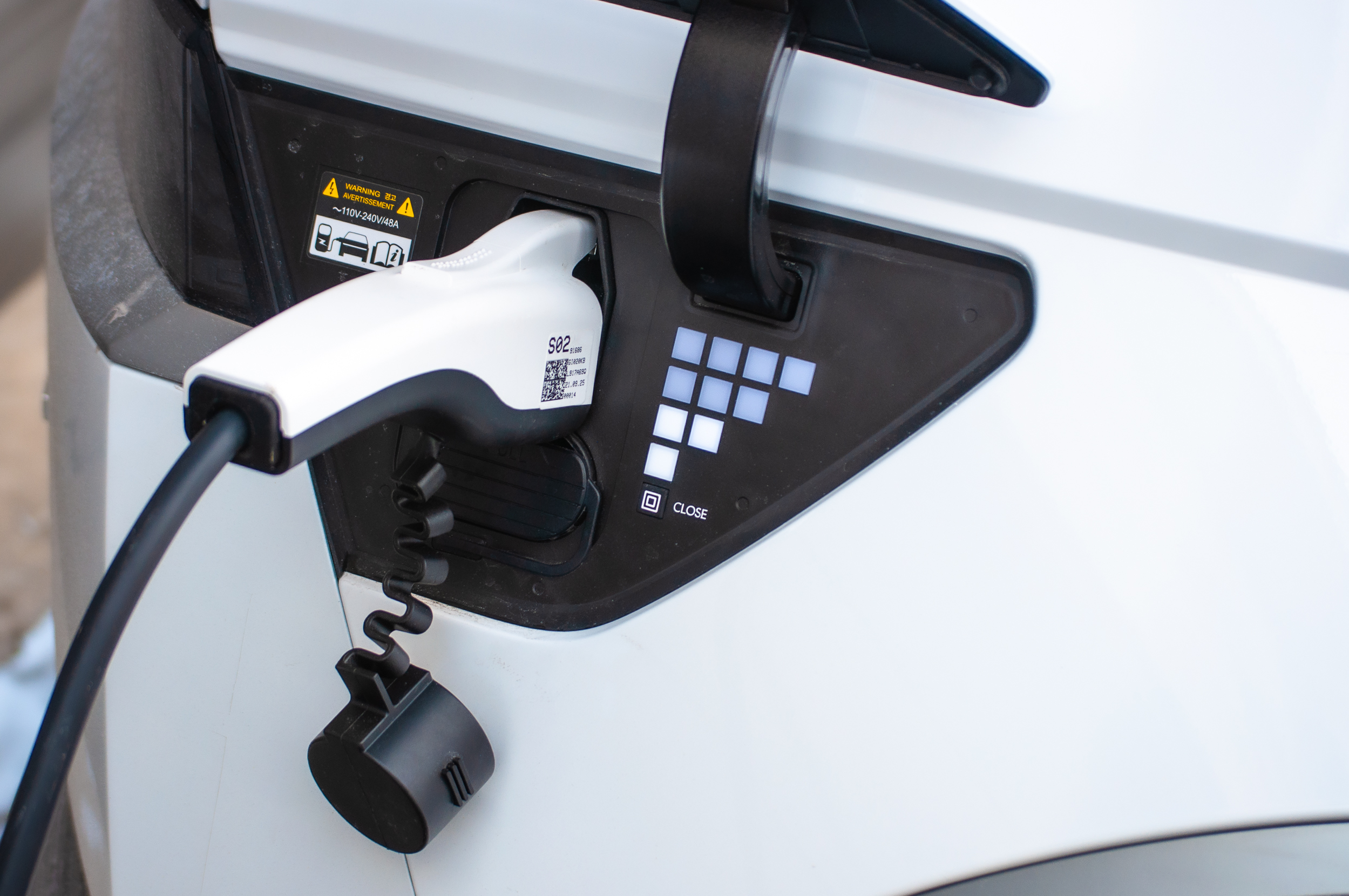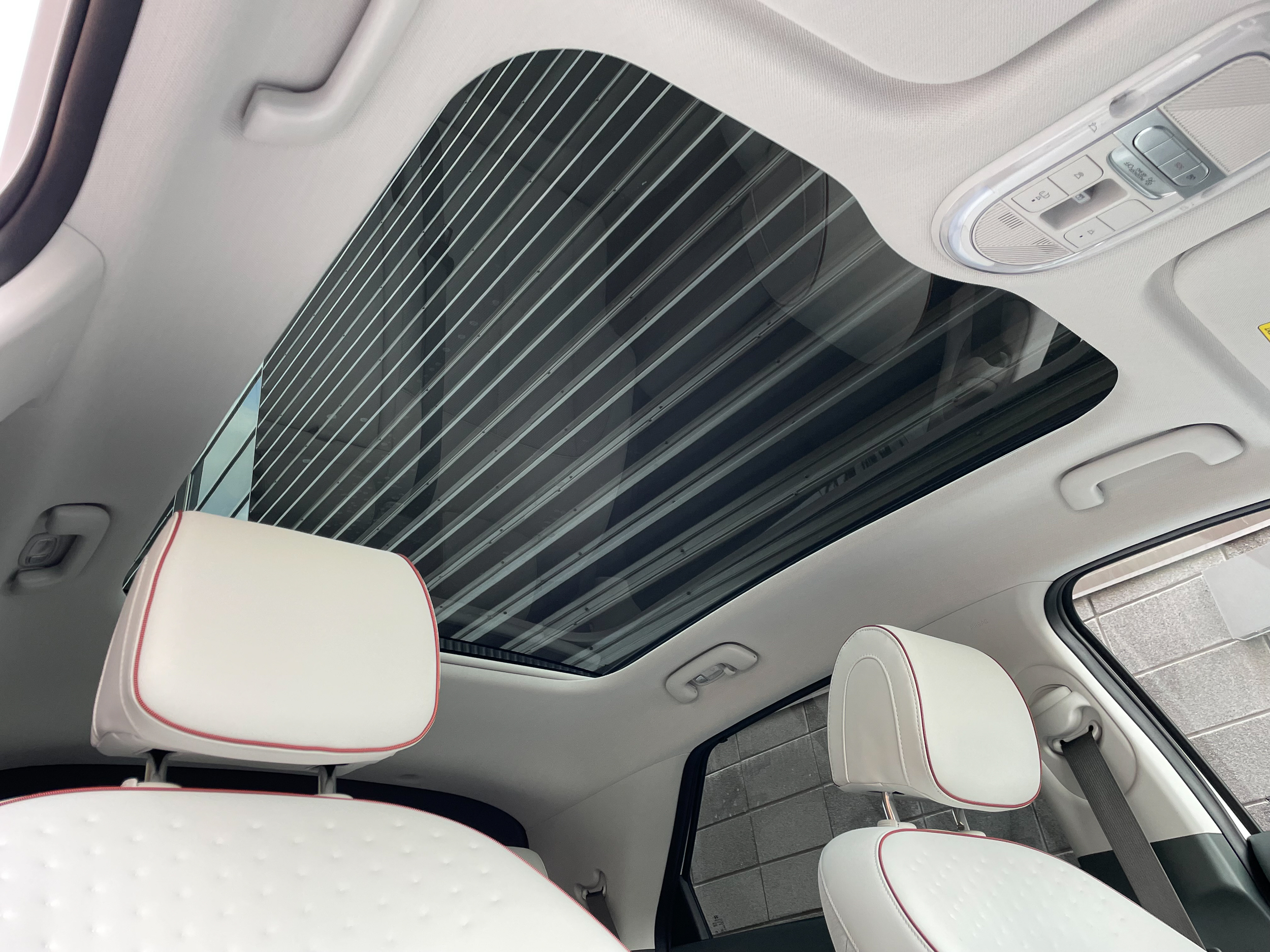A police cruiser rolls to a stop next to me.
This happens every time on one of these photoshoots. No sooner has our test model been positioned within the frame and the DSLR lens been uncapped, we’re joined by either a squad car or local security enquiring what we’re up to. Given that my current location is on Hamilton’s MacMaster University campus, I’m expecting a polite but firm “bugger off” as I saunter across to meet them with as much bonhomie as I can manage.

2022 Hyundai Ioniq 5 / James Gent, The Charge
Down rolls the window, a couple of “afternoon”s are posited in both directions, and the driver’s finger soon angles its way out of the window towards the offending vehicle: a 2022 Hyundai IONIQ 5.
“That… is seriously cool! Do you mind if I take a closer look?”
Though slightly taken aback, I can’t say I’m completely shocked by this revelation. Indeed, when the IONIQ 5 first arrived last year, one of the benefits of its EV-dedicated ‘E-GMP’ base, aside from being the scalable platform on which all electric Hyundais and Kias will be built, was the “new design freedom” said architecture offered. And my word, it does not disappoint.

2022 Hyundai Ioniq 5 / James Gent, The Charge
Beneath those slick quad-headlights and chiselled, v-shaped ‘chin’, there’s no front grille at all, which, when coupled with the subtle fluting across the hood, gives an elegant yet wonderfully aggressive look to Hyundai’s new EV flagship. Down the sides, sharp bodylines pivot towards each other – one bisecting that subtly contoured lower door skin – that are bookended by two of four “aero-efficient” (née ‘ornate’) 20-inch alloys, and wheel arches reminiscent of the 007 gun barrel. At the back, below the tail-lip spoiler, pixelated LEDs continue through the full-width light bar emphasizing those “strong” C-pillars. Oh, and did I mention the flush door handles?
In another neat touch, the ‘fuel filler cap’ hydraulically rotates upwards rather than springs sideways when opened, and a tiered row of pixels light up during charging to illustrate how much of the battery life has been recouped.

2022 Hyundai Ioniq 5 / James Gent, The Charge
The end result, to this particular scribe at least, is glorious.
Unsurprisingly, this sculpted modernity is continues in the cabin. The hyper-minimalist dashboard boasts just two digital displays – the centre-mounted 12.3-inch instrument cluster and the driver information screen – below which are controls and vents for climate control (in a neat touch, this style is replicated full-width across the dash). Beneath the ‘Universal Island’ – slightly nauseating speak for ‘slidable centre armrest’ – there’s bags of storage space, plus a USB and 12-volt charger. Even the gear shifter, affixed with a rotary dial, has been mounted to the steering column to make vehicle egress and exit easier. A practicality spoiled only slightly by the fact there’s now no reach options for the steering wheel and it’s still a reasonable step over the widened door sill.

2022 Hyundai Ioniq 5 / James Gent, The Charge
Boasting the largest wheelbase of the brand’s North American lineup at 3,000 mm means rear-bench space is cavernous. There’s a generous amount of trunk space behind that, too.
“One thing you may notice…” I mention to my learned friend as I reposition the car for a profile shot (“Don’t scuff the wheels! Don’t scuff the wheels! Don’t scuff the wheels!”) is the also determined lack of Hyundai badges in the cabin, save the briefest flash of an ‘H’ on the infotainment screen when the powertrain is shut down. In their place are those pixelated squares, embossed on the steering wheel, the door and dash upholstery, and, very subtly, across the seats. Even the ‘H’ emblems on the nose, tail and wheels are put firmly in the shade by the ‘IONIQ 5’ emblazoned across the trunk hatch.

2022 Hyundai Ioniq 5 / James Gent, The Charge
The message, then, is clear. This EV is the start of an exciting, eco-friendly, and perhaps most important, image-conscious new era. This is not a mainstream Hyundai. It’s an aspirational ‘IONIQ.’
Which would be all well and good, were it not for a few examples of ‘form’ over ‘function’ with the Korean brand’s otherwise beautifully high-quality new electric trendsetter. The lack of a rear windshield wiper, for example, is a particular drag in heavy rain, and, while they look the part, those flush door handles can prove troublesome: twice, when the temperature dropped below -10C, I’ve had to stop the car and ‘encourage’ at least one of them back into its locked position.

2022 Hyundai Ioniq 5 / James Gent, The Charge
Though predominantly easy-to-use most of the time, the lack of a ‘Home’ button for the infotainment touchscreen means there is slightly more faffing around required between sub-menus. One does have to wonder why the heated seat controls – accessible through a haptic button labelled ‘Warmer’ – was mounted right next to the ‘cooler’ button, which can trick even the sharpest mind – so I’ve been told, anyway… – while on the move. I’d also suggest the pseudo-divots in the seat back are a step too far, and can only imagine someone on the IONIQ design team was a big fan of The Road Warriors.
I line up for another shot, silently cursing the mid-afternoon sun that intermittently throws hot spots on the Atlas White bodylines. This might have been easier with the metallic ‘Lucid Blue Pearl’, though that’s a hefty $1,000 commitment for an amateur photographer…

2022 Hyundai Ioniq 5 / James Gent, The Charge
“So, what’s it like to drive?,” our uniformed friend continues, now from the passenger seat.
With years of driving with an automatic shifter meaning ‘forward for Drive’ and ‘backwards for Reverse’, the rotary gear shift stalk does take a little getting used to. But like most of the other functional ‘faults’, this becomes only a fleeting concern when you’re on the move. Give or take the occasional raw edge – which quite honestly is more down to the condition of the road than the suppleness of the suspension – the ride is extremely comfortable, with only a modicum of road roar filtering through. Reach options aside, there’s bags of head, shoulder and legroom for even my lofty 6ft 2in self, the former aided by the massive ‘Vision’ moonroof stretching pillar to post (though the good lady does note I’m sitting a little closer to the roofline than perhaps I realize).
“And what about power?”

2022 Hyundai Ioniq 5 / James Gent, The Charge
Turns out there’s quite a bit of that too. 320 hp and 446 lb-ft worth, to be precise, in this dual-motor example, outfitted as it is with a 77.4 kWh lithium-ion battery (the lower-trim rear-wheel drive versions come with a smaller 58 kWh battery).
Not that you’ll feel too much of this in ‘Eco’ mode, one of four at your immediate disposal on the multi-functional steering wheel. There’s a deft trickle of power as the electric motors begin wafting their way from A to B, the almost overly-assisted steering and blue-hewed real-time battery life counter on the driver’s instrument cluster adding to, rather than deflecting from, the smooth ride. You’re briefly lulled into believing the IONIQ is a comfortable yet docile family mover. An unfettered example of motoring ‘style.’
All this changes when ‘Sport’ mode is selected, and that grunt truly comes to the fore.

2022 Hyundai Ioniq 5 / James Gent, The Charge
There’s an instantaneous surge of torque as the electric motors spool into life, encouraged by even the faintest of throttle blips, a flux emphasized thereafter as the power starts to build and build. Any doubts about this SUV’s sub-five-second 0-100 km/h time vanish as a tangible force pushes you back into the grey two-tone leather.
What mere seconds ago had been ‘pliable’ is now… not aggressive (there’s still too much civility to the linear power delivery for that to be the case) but almost hyper-alert, akin to a sprinter, dripping with adrenaline, poised on the starting blocks waiting for the starter’s pistol.

2022 Hyundai Ioniq 5 / James Gent, The Charge
It’s a vivacity that seeps into the steering column too, the previously isolated feeling now tauter and more direct, if still a little overly power-assisted to make it fully consistent from lock-to-lock. A sensation that could easily be overwhelmed by a heavy front-end or a high centre of gravity (not unreasonable for a five-seater SUV), but which, in the IONIQ 5, is complimented wonderfully by surprisingly little body roll and an impressive amount of grip from the front tires. There’s still trace hints of understeer when you really step on it – this is still a two-ton family wagon we’re talking about – but there’s enough confidence in the front end, and more than sufficient agility when you step on it that, were you to take the IONIQ (firmly if not heavy-handedly) by the collar and thrash it, you could.
The only doubts that might linger are the brakes. There’s plenty of progressive stopping power through the pedal, but the response is not quite as authoritative as that immediate rush of acceleration deserves / requires.
“And what about the price?” our friend enquires, clambering out of the passenger seat. Mind the sill…

2022 Hyundai Ioniq 5 / James Gent, The Charge
That’s when things get a little tricky. This particular model is the top drawer Preferred AWD Long Range trim, prices for which start at the top end of $59K, though our ‘Ultimate Package’ example is closer to $62K. For that you do admittedly get 400 km of range – theoretically at least, since the colder temperatures drop this to 317 km during our test – a total bettered only by the $51,999, rear-wheel drive Preferred Long Range that offers 480 km. Bear in mind that model sacrifices the moonroof, those 20-inch wheels, and the updated surround sound system. But this also has a neat program called Surround View Monitor, which use cameras mounted just above the wheel arches for added visibility when changing lanes on the highway. A system that works incredibly well alongside, rather than instead of, the side mirrors, and only distorts in very heavy rain.
Curiosity sated, the officer bids me good luck with the rest of my shoot, and, confident I’m not blocking traffic, makes his way back to the cruiser. I briefly wonder whether I can include them both in a couple of images, but ultimately bottle it.

2022 Hyundai Ioniq 5 / James Gent, The Charge
The shoot continues throughout the day, students, every so often throwing a glance at the IONIQ 5, such is the allure of that sculpted bodywork. This alone might be enough to consider the Hyundai’s EV a ‘design study’ with little substance, given that it received only the lightest of facelifts when it first appeared as the ‘45’ concept in 2019.
That though would do both the spirited drivetrain and refined road-holding beneath it, to say nothing of interior practicality, a huge disservice. Yes, fine, there are a few instances where form has painted function into a corner – those flush door handles in particular could prove problematic long-term, the easily operable infotainment system can be unnecessarily fiddly – but the 5 nevertheless represents a solid departure in more ways than one from Hyundai’s mainstream appeal.
As an ‘IONIQ’, this five-seater crossover will turn heads from a whole new set of buyers. And not just because a police officer may occasionally take an interest in the design.






